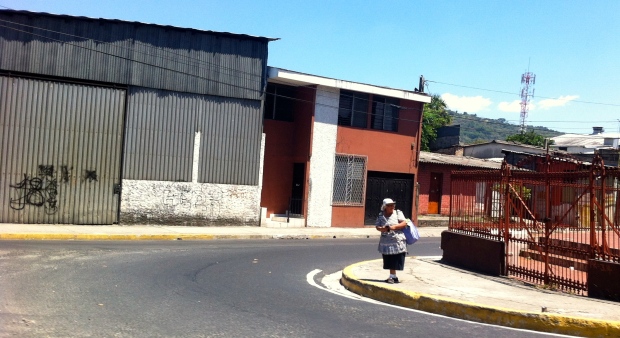You can read the full story (Flood of child migrants a neglected challenge by Politico’s David Rogers) at this link: http://www.politico.com/story/2014/05/flood-of-child-migrants-a-neglected-challenge-107198_Page2.html .
She has studied the crisis from both sides of the U.S. border, including a stint now as a Fulbright fellow in El Salvador. All the Salvadoran children must cross Mexico at some point to get to the U.S. — and many are intercepted and turned back by Mexican authorities. Kennedy has collected over 400 interviews by going to the migrant return center and talking with waiting family members and their children once they arrive.
“Most of the children I meet at the bus return center will try again, and some will reach the United States,” she said. “I’m in contact with 20 who have done so since I got here in October. I’m sure others have arrived and have elected not to stay in contact with me.”
“Over 90 percent of child migrants here have a family member in the U.S,” Kennedy said. “Despite these numbers, less than a third mention family reunification as a reason for emigrating. More often than not, their neighborhood has become so dangerous or they have been so seriously threatened, that to stay is to wait for their own death or great harm to their family. Their neighborhoods are full of gangs. Their schools are full of gangs. They do not want to join for moral and political reasons and thus see no future.”
“In only one of 400-plus interviews did a child migrant ask about the DREAM Act and immigration reform. … Fifteen had heard that the U.S. system treated children differently than adults and wanted to know how. In all 15 cases, the child had received a threat to join the gang or be killed, and some had then been beat or raped when they refused to join.”
“Thus, there is only limited knowledge of the way the U.S. system works for children. U.S. legislation is not driving this emigration. A humanitarian crisis is. We need to accept that when large amounts of people leave a country, this is indicative of untenable problems in that country. … Until the root causes are addressed, it’s going to continue.”
‘The reality is that violence — homicide, rape, kidnapping, extortion, disappearance — is at near an all-time high,” Kennedy said of her time in El Salvador. “And it has a disproportionate impact on young people.”
CITA EXTENSA EN POLÍTICO
Puedes leer el artículo completo (Diluvio de niños migrantes, un reto descuidado, por David Roger de Político en este link http://www.politico.com/story/2014/05/flood-of-child-migrants-a-neglected-challenge-107198_Page2.html .
Elizabeth Kennedy, candidata doctoral en la Universidad Estatal de San Diego, pinta un cuadro diferente.
Ella ha estudiado la crisis desde ambos lados de la frontera de EE.UU., incluyendo ahora una estancia como becaria Fulbright en El Salvador. Todos los niños salvadoreños deben cruzar México en algún momento para llegar a los EE.UU. — y muchos son interceptados y retornados por las autoridades mexicanas. Kennedy ha realizado más de 400 entrevistas yendo al centro de retorno de migrantes y hablando con los familiares en espera y con sus niños retornados, una vez que llegan.
“La mayoría de los niños que me encuentro en el centro de retorno por autobús, lo intentarán de nuevo, y algunos llegarán a Estados Unidos”, dijo. “Estoy en contacto con 20 que lo han logrado desde que llegué aquí, en octubre. Estoy segura de que otros han llegado y han optado por no estar en contacto conmigo”.
“Más del 90 por ciento de los niños y niñas migrantes aquí tienen un miembro de la familia en los EE.UU.”, dijo Kennedy. “A pesar de estos números, menos de un tercio mencionó reunificación familiar como la razón para emigrar. Más a menudo, sus barrios se han vuelto tan peligrosos o han sido seriamente amenazados, que quedarse es esperar la propia muerte o un gran daño para sus familias. Sus barrios están llenos de pandillas. Sus escuelas están llenas de pandillas. Ellos no quieren unirse a estas, por razones morales y políticas y, por lo tanto no ven un futuro”.
“En sólo una de las más de 400 entrevistas realizadas, un niño migrante preguntó sobre el DREAM Act y la reforma migratoria. … Quince habían oído que el sistema de los EE.UU. trataba a los niños de manera diferente que a los adultos y querían saber cómo. En los 15 casos, el niño había recibido una amenaza para unirse a la pandilla o ser asesinado, y algunos, luego habían sido golpeados o violados por haberse negado a unirse. ”
“Por lo tanto, sólo hay un conocimiento limitado de la forma en que el sistema de los EE.UU. trabaja para los niños. La legislación de EE.UU. no está conduciendo esta emigración. Es una crisis humanitaria. Tenemos que aceptar que cuando grandes cantidades de personas dejan un país, es un indicativo de problemas insostenibles en ese país. … Mientras no se aborden las causas profundas, esto va a continuar”.
“La realidad es que la violencia – el homicidio, la violación, el secuestro, la extorsión, la desaparición – están en su máximo en la historia”, dijo Kennedy de su tiempo en El Salvador. “Y tienen un impacto desproporcionado en los jóvenes.”


